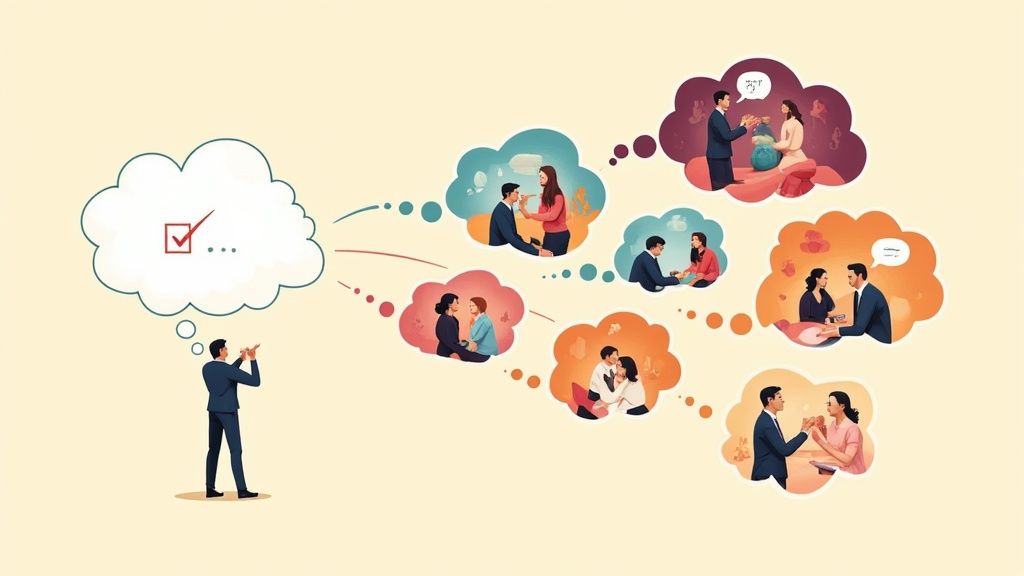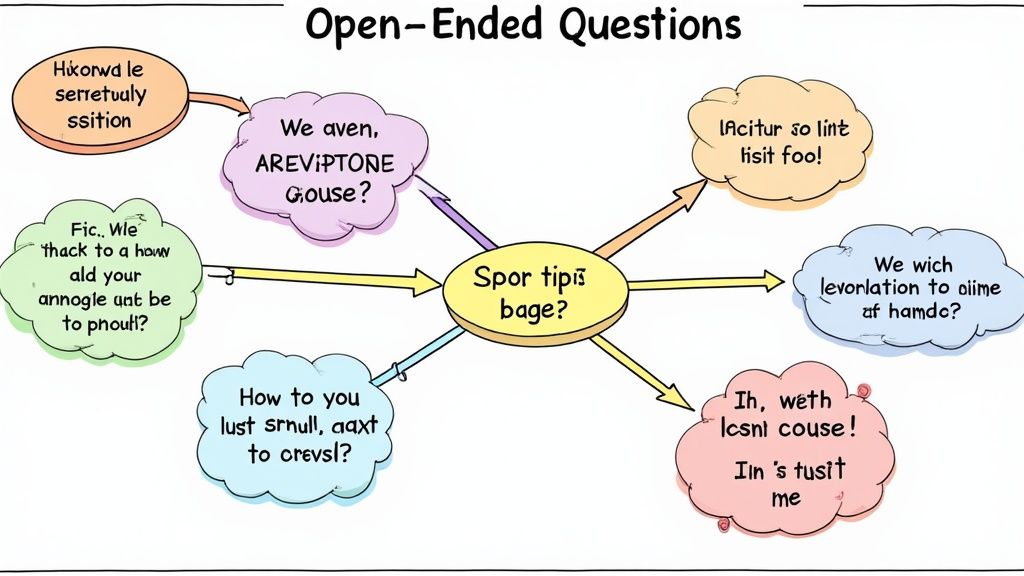50+ Examples of Open-Ended Questions: A Research-Backed Guide for Getting Real Answers

Why Most People Ask the Wrong Questions (And How to Fix It)

We often limit the value of our conversations without realizing it. By defaulting to simple yes/no questions, we miss opportunities to gain deeper insights and build genuine connections. These closed-ended questions can stop meaningful dialogue in its tracks, leaving us with surface-level answers that don't tell the full story.
For example, consider a customer service interaction. Asking a customer "Are you satisfied with our service?" yields only a basic yes or no response. But reframing it as "How would you describe your experience with our service?" opens the door for detailed feedback about what worked well and what needs improvement. This shift from closed to open questions helps companies better understand their customers' real needs.
The Power of "Why" and "How"
Getting richer, more insightful responses starts with asking better questions. Open-ended questions that begin with "why," "how," or "what" invite people to share their complete thoughts and perspectives. Think of closed questions as taking a quick glance at a locked treasure chest – you see the outside but miss all the valuable details within. Opening that chest requires thoughtful questions that encourage elaboration.
Studies consistently show that the way we frame questions directly impacts the quality of responses we receive. Open-ended questions allow people to freely express their views and provide important context that closed questions simply cannot capture. This matters especially in fields like market research, where understanding consumer motivations and behaviors drives product development and marketing decisions.
Transforming Results Through Strategic Questioning
Experienced researchers and interviewers know that the right questions make all the difference. When they shift from closed to open-ended questions, they see major improvements in the depth and usefulness of their findings. For example, qualitative studies using open questions gather rich, descriptive data that helps explain complex behaviors and attitudes – something that's much harder to achieve with simple yes/no questions focused on statistics.
Consider how this works in practice with a tool like SupportMan. By asking customers open-ended questions like "What could we have done to improve your experience?", companies collect specific, actionable feedback right in their Slack workspace. This helps support teams quickly address issues and understand the real drivers of customer satisfaction. Moving beyond basic rating scales to thoughtful questions turns feedback into a powerful tool for ongoing improvement and building stronger customer relationships.
Crafting Questions That Get People Talking
The art of asking good questions goes beyond simple yes/no responses. By carefully choosing words and phrasing, you can encourage others to share deeper insights and detailed perspectives. Just like having the right keys opens doors, asking the right questions opens up meaningful dialogue and understanding.
Frameworks for Building Trust and Dialogue
Start with questions focused on "why," "how," and "what" to encourage explanation and exploration. For instance, rather than "Are you happy with our product?", ask "What aspects of our product do you find most valuable, and why?" This approach reveals specific features customers care about and their underlying motivations. When you ask "how" questions like "How did you handle this situation?", you gain insight into someone's problem-solving approach and decision-making process.
Personal stories and experiences also lead to richer conversations. Instead of requesting opinions, invite relevant examples: "Can you tell me about a time when you faced this kind of challenge?" This helps people draw from their own experiences while revealing their values and approaches. In interviews especially, story-based questions provide deeper understanding of a candidate's character and capabilities beyond surface-level responses.
Examples of Open-Ended Questions in Action
Here are some proven open-ended questions for different settings:
- Customer Feedback: Instead of "Would you recommend our product?", try "What would you tell a friend who was considering using our product?" This mirrors natural word-of-mouth recommendations.
- Market Research: "What factors influence your purchasing decisions for [product category]?" This reveals key drivers of consumer choices and preferences.
- Journalism: "Can you describe the scene when…?" This helps paint vivid pictures for the audience through rich details.
- Team Meetings: Rather than "Are there any roadblocks?", ask "What challenges are we facing, and how might we overcome them?" This sparks collaborative problem-solving. Tools like SupportMan can help capture and analyze this open-ended feedback within your team's communication platform.
The Impact of Phrasing
Small changes in question phrasing can dramatically affect response quality. Compare "What are your thoughts?" to "What are your deepest thoughts about this?" That single word "deepest" encourages more reflective answers. Similarly, "Describe…" often leads to more detailed responses than "Tell me about…" Being thoughtful about word choice transforms basic information exchanges into chances for genuine connection and understanding.
Research-Backed Questions That Drive Customer Insights

Well-designed questions are key to understanding your customers at a deeper level. The most effective companies know that going beyond simple yes/no questions and using targeted open-ended questions uncovers valuable insights about customer needs, preferences and pain points. This section explores how to craft questions that get to the heart of the customer experience.
Uncovering the "Why" Behind Customer Behavior
Getting to the real reasons behind customer actions helps companies improve their offerings and build stronger relationships. Rather than asking "Are you satisfied with our service?", consider questions like "What aspects of our service work best for you and why?" This pulls out specific details about what customers truly value. For example, a customer might share that 24/7 chat support helps them feel confident using your product, even if they rarely need assistance. These kinds of insights shape everything from product updates to marketing messages.
Examples of Open-Ended Questions That Deliver Results
Here are some field-tested open-ended questions that consistently generate useful feedback:
- Understanding Customer Needs: "What challenges do you face when using [product category]?" This surfaces pain points you may not have considered.
- Evaluating User Experience: "How would you describe your experience navigating our website?" This highlights usability issues that need fixing.
- Gauging Customer Satisfaction: "What would have made your recent purchase experience better?" This reveals gaps between expectations and reality.
- Assessing Product-Market Fit: "How does our product help you get your work done?" This shows whether customers see value in ways that match your vision.
Tools like SupportMan make it easy to gather this feedback directly in Slack, so support teams can respond quickly and work together effectively.
Adapting Questions to Specific Industries and Audiences
While good questions follow similar patterns, the exact wording needs to fit your audience. B2B customers expect different language than consumers. Technical users require more precise terms than general audiences. The key is matching questions to how your customers think and talk. For example, asking software developers about "pain points" works better than "challenges." Consider cultural context too – what resonates in one region may fall flat in another.
Practical Templates and Strategies for Implementation
Building a library of proven question templates saves time and ensures consistency. Start with basic formats, then customize them for each research goal. Think through how you'll use different channels – surveys work differently than interviews or focus groups. Analyze patterns in the responses to spot trends and opportunities. Most importantly, turn those insights into real improvements. When customers see their feedback leading to positive changes, they're more likely to keep sharing valuable perspectives that help your business grow.
Interview Questions That Reveal What Really Matters

Making the right hire depends on asking questions that uncover a candidate's true potential. Basic interview questions often get rehearsed answers that don't tell you much. The key is asking thoughtful, open-ended questions that reveal how someone thinks, works, and would fit with your team. Instead of relying on standard questions, focus on prompts that spark meaningful discussion.
Uncovering Problem-Solving Skills
Rather than asking candidates to list their strengths, present real scenarios they might face. For example, ask "Tell me about a complex work challenge you've faced. What steps did you take to solve it?" This reveals their actual problem-solving process and decision-making style. Follow up with questions like "What did that experience teach you?" to understand how they learn and adapt.
Assessing Cultural Fit
Finding the right cultural match matters for long-term success. While basic questions show surface preferences, targeted open-ended questions help understand someone's values and work style. Ask things like "How do you prefer to receive feedback?" or "What does your ideal work environment look like?" to glimpse how they communicate and collaborate. Tools like SupportMan can help gather team feedback to build a culture of growth starting with hiring.
Beyond the Rehearsed Response
Most candidates prepare extensively for common questions. To get authentic responses, craft questions that require real reflection. Instead of "Why do you want this job?" try "What specifically excites you about this role and how does it connect to your career goals?" This shows their genuine interest and motivation beyond just getting hired. These insights help identify candidates who truly connect with your mission.
Practical Examples for Different Roles
Questions should match the specific role. Here are some examples:
- Sales: "Tell me about a sale you lost. What did you learn?" This shows resilience and ability to grow from setbacks.
- Marketing: "How would you explain a complex concept to someone with no technical background?" This tests communication and ability to simplify ideas.
- Engineering: "Describe solving a technical problem with limited information. What was your approach?" This reveals resourcefulness under constraints.
By using thoughtful open-ended questions, you can transform interviews from basic Q&A into meaningful conversations that reveal candidates' true potential and fit for your team.
Avoiding Common Question Traps
The art of asking good questions requires more than just knowing which questions to ask – it also means avoiding common mistakes that can muddy the waters and prevent you from getting meaningful responses. Professionals at all levels can fall into these question traps, so learning how to spot and sidestep them is essential for conducting effective research and interviews.
The Danger of Leading Questions
One of the biggest pitfalls is asking leading questions that subtly push respondents toward a particular answer. For example, rather than asking "Do you think our product is easy to use?" (which suggests the "right" answer), try "How would you describe the usability of our product?" This neutral wording gives respondents space to share their honest thoughts. Getting feedback free from bias is especially important when collecting customer insights to improve products and services. Tools like SupportMan can help spot patterns in customer responses and identify where leading questions may have skewed the data.
Diving Deeper Than Surface-Level Answers
People often give brief, non-specific responses when discussing complex or sensitive topics. You might hear vague comments like "It's fine" or "It's good." To get to the heart of the matter, follow up with questions that draw out details: "What specifically made it good?" or "Can you tell me more about that?" These prompts encourage respondents to elaborate and share richer insights about their experiences.
Maintaining Objectivity in Questioning
Personal biases can color both how we ask questions and interpret answers. Creating a structured interview guide with pre-written, open-ended questions helps maintain consistency and prevents asking different questions to different respondents. Another useful practice is conducting blind analysis – reviewing responses without identifying information to reduce bias. This approach is particularly valuable in market research where understanding authentic consumer behavior is critical.
Recovering from Questioning Mistakes
Even with careful planning, you may sometimes ask a question that falls flat or confuses the respondent. The key is recognizing when this happens and pivoting gracefully. If someone seems puzzled, try rephrasing the question or providing a clarifying example. For instance, if asking about a specific feature leads to confusion, explain the feature's purpose in simpler terms. Don't hesitate to acknowledge confusion – showing this respect builds trust and encourages more open, detailed responses. By understanding these common traps and having strategies to recover from them, you'll be better equipped to gather valuable insights that drive real improvements.
Mastering Question Delivery Across Different Contexts

The impact of an open-ended question depends heavily on how and when you ask it. Like any skilled professional, knowing which approach to use in each situation makes all the difference. Success comes from understanding the nuances of timing, word choice, and follow-up strategies. A question that works perfectly in a focus group setting may fall flat in an online survey. Let's explore how to adapt your questioning techniques to get meaningful responses across different contexts.
Optimizing Questions for Digital Surveys
While digital surveys offer an efficient way to collect feedback at scale, crafting effective questions requires careful consideration. The key challenge is finding the right balance – you want questions that are brief enough to prevent survey fatigue but detailed enough to gather useful insights. Keep questions focused on one topic at a time. Rather than asking "What do you think about our product and what improvements would you suggest?", split this into two clear questions: "What are your thoughts on our product?" followed by "How could we improve our product?". This targeted approach leads to more complete responses.
Make sure to give context for each question by explaining why you're asking and how you'll use the information. This transparency helps build trust with respondents. Take advantage of survey logic features to personalize follow-up questions based on previous answers. When respondents feel the questions are relevant to their experience, they're more likely to provide thoughtful feedback.
Navigating Face-to-Face Conversations
In-person interactions give you the chance to dig deeper through open-ended questions. Your body language and tone play a big role in how comfortable people feel sharing their thoughts. Make eye contact and use a friendly tone to encourage open dialogue. Pay close attention not just to what people say, but how they say it – their expressions and gestures often reveal additional meaning. This helps you ask better follow-up questions to explore important points.
When someone brings up a specific issue, a simple "Could you tell me more about that?" shows you're listening and interested in understanding their perspective. Remember that the goal is building genuine understanding, not just collecting data. The human connection you establish leads to richer, more honest responses. Using SupportMan can help your team capture and analyze these valuable conversations effectively.
Facilitating Effective Group Discussions
Group settings require special care in how you structure and guide conversations with open-ended questions. As the facilitator, your role is to create an environment where everyone feels comfortable contributing while keeping the discussion on track. Start with a clear, focused question that sets up productive dialogue. For instance, opening a product development meeting by asking "What major problems do our users face?" gives the group a concrete starting point.
Watch the group dynamics closely. Some people naturally dominate conversations while others hold back. Use subtle techniques to draw out quieter participants and ensure balanced input. Tools like whiteboards or shared documents help organize ideas visually. After the discussion, send a summary of key points and next steps to maintain momentum. This keeps everyone aligned on what was covered and what happens next.
Start using SupportMan to streamline your customer feedback and create a stronger culture of continuous improvement. Connect your Intercom ratings directly to Slack and transform how your team handles support. Begin your free trial today!
What to do next
Whenever you're ready, here's three ways we can help you scale your support org:
- Claim your free Support Manager Handbook. It's a free 30+ page guide filled with strategies, tactics, and best practices for scaling your support org. Download it here.
- Subscribe to our Support Ops newsletter to get the latest updates here.
- Set up Internal Documentation with Tettra to start automatically answering the questions you get in Slack. Here's how.

